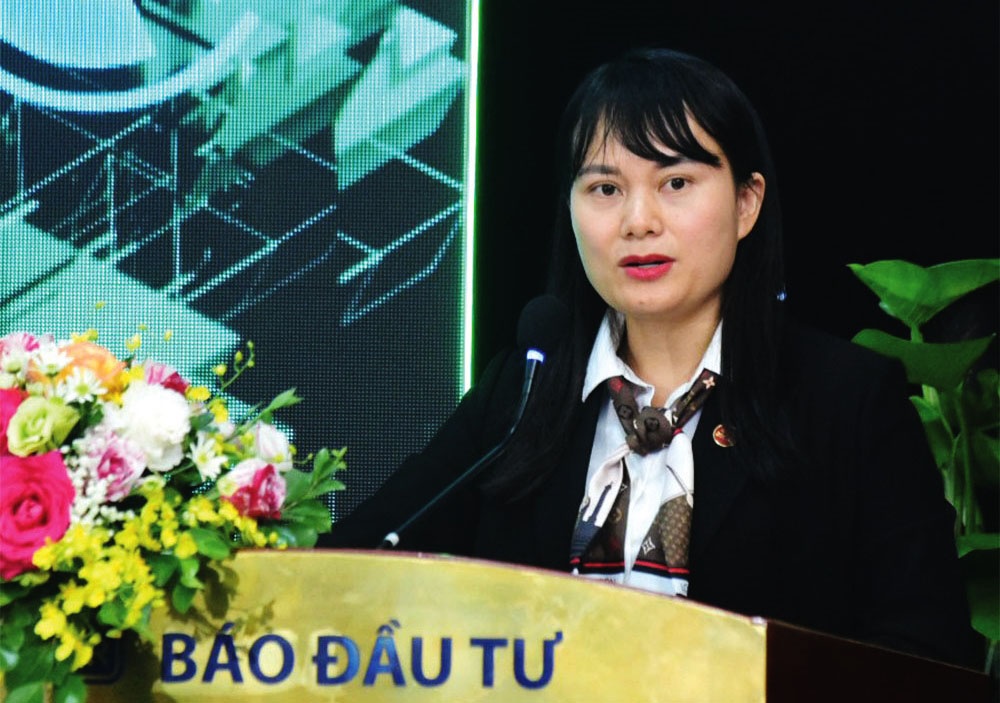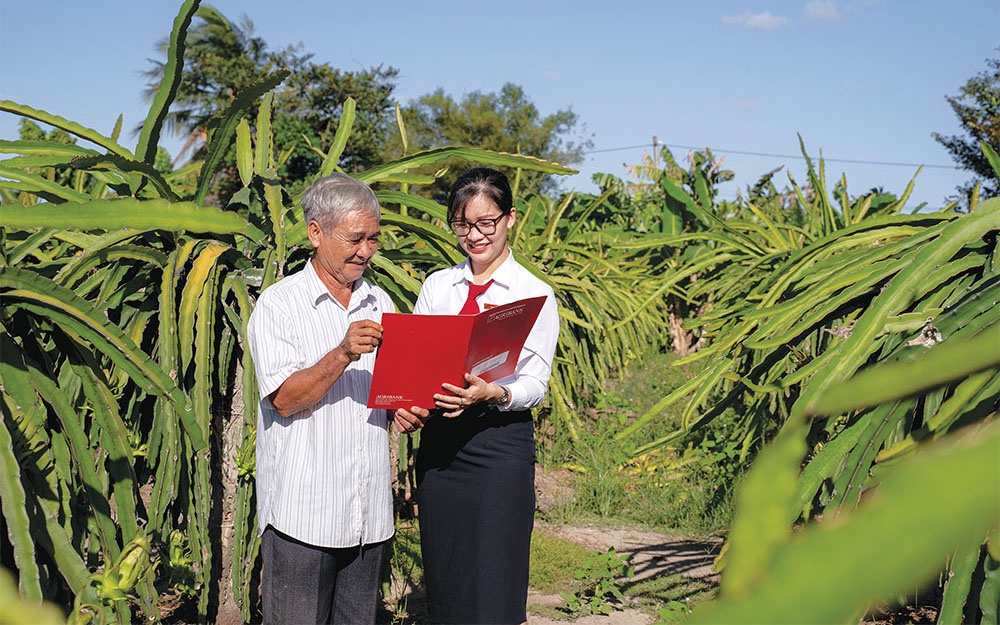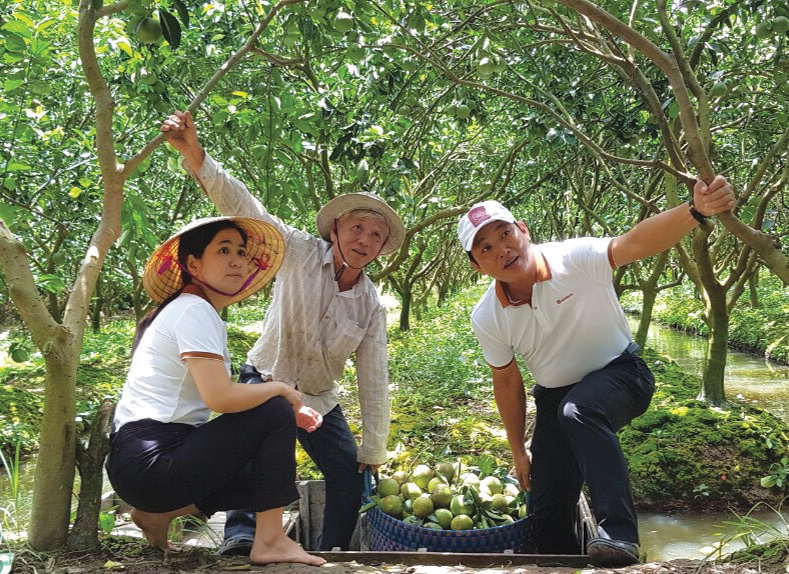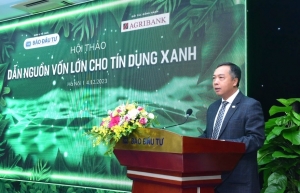Agribank boosts ability to provide greener credit
 |
| Phung Thi Binh, deputy general director of Agribank |
As the primary financial institution supporting the agricultural and rural sector in Vietnam, how has Agribank contributed to the imperative of reducing greenhouse gas emissions?
As of October 31, Agribank’s outstanding loans in the agricultural sector reached more than 63 per cent. The bank has issued a series of documents on promoting green credit growth and managing environmental and social risks in credit granting activities, including a preferential credit initiative with unlimited capital for clean agricultural production since 2016, with lending interest rates reduced.
 |
From Agribank’s funding, many large-scale agricultural production models have been formed in all regions of the country, such as the flower growing model in Lam Dong, basa fish in An Giang, pig farming in Ha Nam, and sugarcane in Khanh Hoa. To date, Agribank’s clean agricultural and high-tech agricultural loan revenue have accounted for half of total capital for this field.
Agribank is coordinating with the Ministry of Agriculture and Rural Development to realise the goal of forming one million hectares by the end of this decade, specialising in high-quality and low-emission rice cultivation, reorganising the production system along the value chain, and contributing to Vietnam’s implementation of international commitments.
We also actively participate in many projects related to environmental protection sponsored by the World Bank and other financial organisations. These include a coastal resources project for sustainable development, natural disaster risk management, clean water supply and rural sanitation in the Red River Delta, and so on.
 |
In addition to clean agriculture and technology, how does Agribank allocate credit into other green fields?
Deeply aware of the challenges of climate change in agriculture, Agribank is determined to take the lead in implementing the State Bank of Vietnam’s (SBV) direction on promoting green credit.
Our loan balance for green fields has seen steady growth each year. In 2018-2020, green credit balance grew rapidly from 100 to 380 per cent per year. After this period, due to the influence of macro factors, the growth rate of outstanding loans has slightly decreased, but is still quite stable in terms of loan value and number of customers.
As of September 30, outstanding loans for the green sector reached almost $500 million, with almost 42,000 customers. Of which, outstanding debt in the sustainable forestry sector accounts for 55 per cent of total outstanding green credit debt. Next is the field of renewable energy and clean energy, with outstanding loans accounting for 22 per cent of total outstanding green credit loans. The third is green agriculture, accounting for 16 per cent of total outstanding green credit debt.
In terms of the number of loan customers, the sustainable forestry sector is responsible for the highest proportion, with 99 per cent of the total, down 2.3 per cent over the same period in 2022. However, loan projects with high values mainly belong to the field of renewable energy and clean energy, including large-scale wind power and solar power loan schemes.
Some typical projects in this vein in Vietnam include two wind power ventures from Trung Nam Group, as well as Phuong Mai 1 power station, located in Binh Dinh province.
 |
The demand for green credit is currently considerable. How do you assess Agribank’s ability to provide capital in this area?
In pursuit of a green, circular, and environmentally friendly economy, Agribank prioritises capital allocation to expand loans for development projects, emphasising agricultural and rural initiatives that foster added value, clean energy, and high-tech agriculture.
With an extensive customer base and the largest market share in Vietnam, the bank stands as a substantial source for green credit. Despite its significant credit capacity, surpassing $5 billion for both domestic and foreign loans and deposits, Agribank has yet to fully leverage these resources.
Moreover, the bank is actively working on a plan to establish a green bond framework, adhering to international standards, aiming to issue green bonds that will mobilise capital for financing green projects.
Numerous foreign financial institutions stand prepared to offer green credit for sustainable development projects and businesses. What measures should Vietnam undertake to optimise the absorption of international capital inflows most effectively?
According to the German Development Agency, the total international green financial resources committed to Vietnam in the next 3-5 years is about $2.25 billion, of which nearly $1.2 billion is international green bonds.
The opportunity for Vietnamese businesses and financial institutions to access international green capital sources is huge, but the proportion of outstanding green credit debt is still quite modest, concentrated mainly into fields such as renewable energy and clean energy (nearly 46 per cent), followed by green agriculture (over 31 per cent), and sustainable water management (about 12 per cent). Meanwhile, many other important areas in environmental protection and response to climate change, such as waste management, transportation and sustainable construction, received limited attention.
To promote maximum absorption of large international capital flows, Vietnam needs to take preparatory steps. The government must expedite the issuance of legal frameworks, regulations, and instructions pertaining to green finance to provide a clear legal pathway for businesses and financial institutions entering the green financial market. This includes enacting a green taxonomy as a foundation for entities to issue and select green projects using capital from green bonds, and establishing a list and criteria for evaluating green production and business industries.
The SBV should further develop guidelines for implementing green banking and green credit for credit institutions, collaborating with organisations and sectors to set criteria and norms for green ventures. Simultaneously, it should drive the development and implementation of separate policies for green credit activities, aligning with green goals to incentivise commercial banks to invest boldly in this sector.
Credit institutions need to intensify training and enhance knowledge among bank staff on green banking, green credit, and environmental and social risk appraisal for green projects. This involves organising training, disseminating knowledge, fostering awareness of efficient energy use, resource conservation, and environmental protection.
There should be a continual mobilisation of resources to implement green credit policy in Vietnam, actively accessing green international capital through ministries, departments, agencies, or direct approaches to financial institutions, non-governmental organisations, and the green credit trust fund established by SECO. This entails raising capital through the issuance of green bonds to finance large-scale, energy-saving renewable energy projects.
Credit institutions should also develop and diversify green credit products to suit their existing resources and each customer group, thereby enhancing competitiveness and attracting customers. Regular checks and monitoring of environmental and social risk management for granted green credit are crucial, ensuring the safety of credit grants while encouraging individuals and businesses to engage in purposeful, safe, and effective endeavours.
Recognising the significance of sustainable business development, Agribank is actively implementing environmental, social, and governance (ESG) standards as a top priority in its development strategy for 2023-2025. Agribank has established a steering committee and supporting team to develop a comprehensive ESG implementation project with the determination to synchronously and effectively implement its application throughout its system.
The bank has issued regulations on environmental risk management and collaborated with international organisations to receive technical funding for building policies and procedures regarding environmental and social risks in credit granting activities. For customers accessing international green capital, a proactive shift towards sustainable development, particularly implementing ESG standards effectively, is essential.
 | Green credit gaining traction at Agribank Top agricultural and rural development lender Agribank remains unwavering in pursuing its green banking strategy to contribute to the sustainable development of Vietnam. |
 | Agribank's green finance initiative: Catalysing Vietnam's eco-friendly economic ascent At the forefront of Vietnam's green finance revolution, Agribank has reported a substantial green credit portfolio of approximately $510 million as of October 31. This revelation came from Phung Thi Binh, deputy general director of Agribank, during the Lighting the Path for Green Financing seminar held by VIR on December 4. |
 | Vietnam's green credit surge: Navigating towards sustainable finance At a VIR seminar on December 4, in collaboration with the Vietnam Bank for Agriculture and Rural Development (Agribank), key stakeholders congregated to discuss Lighting the Path for Green Financing. The forum signified a critical juncture in Vietnam's path towards sustainable development and emphasised green economic growth. |
What the stars mean:
★ Poor ★ ★ Promising ★★★ Good ★★★★ Very good ★★★★★ Exceptional
 Tag:
Tag:
Related Contents
Latest News
More News
- Tax sector wraps up 2025 and sets priorities for next year (December 25, 2025 | 14:00)
- A tipping point for digital and hybrid wealth management in Vietnam (December 23, 2025 | 13:33)
- $250 million deal targets women-owned SMEs, sustainable agriculture (December 22, 2025 | 17:40)
- Stock market posts resilient 2025 performance (December 19, 2025 | 18:17)
- Citi Vietnam receives 2025 AmCham CSR recognition (December 19, 2025 | 16:35)
- As global green supply chain reshapes, will Vietnam be left behind? (December 19, 2025 | 08:00)
- Banks gear up for massive capital increases (December 18, 2025 | 17:04)
- Securing capital and efficiency for Vietnam’s 2026-2030 growth ambitions (December 17, 2025 | 10:00)
- Energy sector in need of blended finance mechanisms (December 17, 2025 | 09:00)
- Vietnam still has room to mobilise capital for sustainable growth (December 17, 2025 | 08:57)























 Mobile Version
Mobile Version